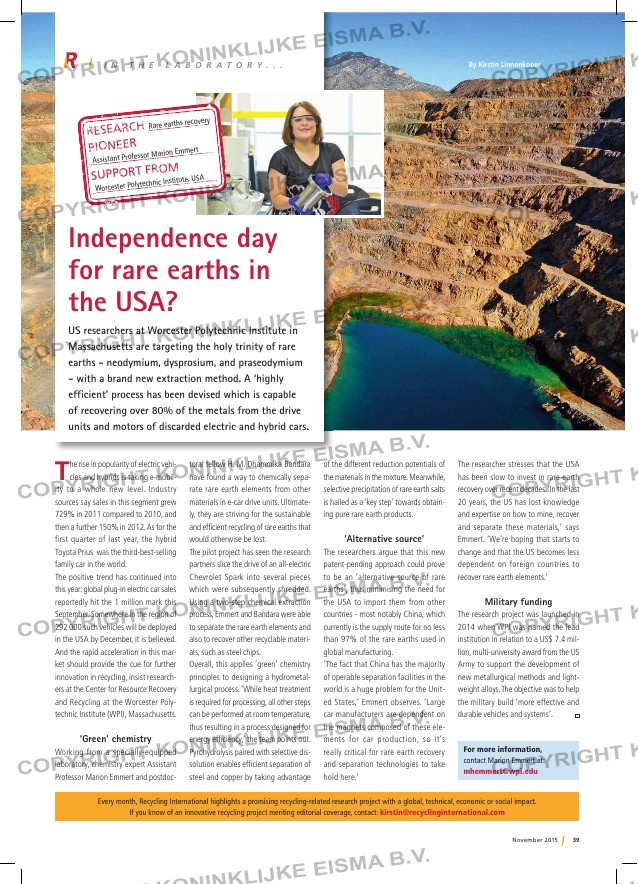Page 41 from: November 2015

Rubrik
39November 2015
I N T H E L A B O R A T O R Y . . .
The rise in popularity of electric vehi-cles and hybrids is taking e-mobil-
ity to a whole new level. Industry
sources say sales in this segment grew
729% in 2011 compared to 2010, and
then a further 150% in 2012. As for the
first quarter of last year, the hybrid
Toyota Prius was the third-best-selling
family car in the world.
The positive trend has continued into
this year: global plug-in electric car sales
reportedly hit the 1 million mark this
September. Somewhere in the region of
292 000 such vehicles will be deployed
in the USA by December, it is believed.
And the rapid acceleration in this mar-
ket should provide the cue for further
innovation in recycling, insist research-
ers at the Center for Resource Recovery
and Recycling at the Worcester Poly-
technic Institute (WPI), Massachusetts.
‘Green’ chemistry
Working from a specially-equipped
laboratory, chemistry expert Assistant
Professor Marion Emmert and postdoc-
toral fellow H. M. Dhammika Bandara
have found a way to chemically sepa-
rate rare earth elements from other
materials in e-car drive units. Ultimate-
ly, they are striving for the sustainable
and efficient recycling of rare earths that
would otherwise be lost.
The pilot project has seen the research
partners slice the drive of an all-electric
Chevrolet Spark into several pieces
which were subsequently shredded.
Using a two-step chemical extraction
process, Emmert and Bandara were able
to separate the rare earth elements and
also to recover other recyclable materi-
als, such as steel chips.
Overall, this applies ‘green’ chemistry
principles to designing a hydrometal-
lurgical process. ‘While heat treatment
is required for processing, all other steps
can be performed at room temperature,
thus resulting in a process designed for
energy efficiency,’ the team points out.
Pyrohydrolysis paired with selective dis-
solution enables efficient separation of
steel and copper by taking advantage
of the different reduction potentials of
the materials in the mixture. Meanwhile,
selective precipitation of rare earth salts
is hailed as a ‘key step’ towards obtain-
ing pure rare earth products.
‘Alternative source’
The researchers argue that this new
patent-pending approach could prove
to be an ‘alternative source of rare
earths’, thus minimising the need for
the USA to import them from other
countries – most notably China, which
currently is the supply route for no less
than 97% of the rare earths used in
global manufacturing.
‘The fact that China has the majority
of operable separation facilities in the
world is a huge problem for the Unit-
ed States,’ Emmert observes. ‘Large
car manufacturers are dependent on
the magnets composed of these ele-
ments for car production, so it’s
really critical for rare earth recovery
and separation technologies to take
hold here.’
The researcher stresses that the USA
has been slow to invest in rare earth
recovery over recent decades. ‘In the last
20 years, the US has lost knowledge
and expertise on how to mine, recover
and separate these materials,’ says
Emmert. ‘We’re hoping that starts to
change and that the US becomes less
dependent on foreign countries to
recover rare earth elements.’
Military funding
The research project was launched in
2014 when WPI was named the lead
institution in relation to a US$ 7.4 mil-
lion, multi-university award from the US
Army to support the development of
new metallurgical methods and light-
weight alloys. The objective was to help
the military build ‘more effective and
durable vehicles and systems’.
Independence day
for rare earths in
the USA?
US researchers at Worcester Polytechnic Institute in
Massachusetts are targeting the holy trinity of rare
earths – neodymium, dysprosium, and praseodymium
– with a brand new extraction method. A ‘highly
efficient’ process has been devised which is capable
of recovering over 80% of the metals from the drive
units and motors of discarded electric and hybrid cars.
By Kirstin Linnenkoper
Every month, Recycling International highlights a promising recycling-related research project with a global, technical, economic or social impact.
If you know of an innovative recycling project meriting editorial coverage, contact: [email protected]
For more information,
contact Marion Emmert at:
[email protected]
RESEARCH
PIONEER
SUPPORT FR
OM
Rare ear
ths recovery
Assistant Prof
essor Marion
Emmert
Worcester Pol
ytechnic Instit
ute, USA



